HP Reverb VR Headset Review: Windows Mixed Reality Never Looked So Good
Why you can trust Tom's Hardware
Benchmarks and Conclusion
Setup Process
The setup process for Windows MR headsets is about as simple as VR calibration gets. You need a Windows 10 PC with at least version 1809 installed, a free USB 3.0 port and the appropriate display output.
To begin the setup, plug in the USB and DisplayPort cables, and Windows should automatically detect that there is an MR headset present and launch the Windows Mixed Reality Portal software. If the software isn't installed, it should prompt an automatic Windows update.
Once the software opens, it asks you to pair the controllers. As noted above, the controllers that ship with the Reverb come pre-paired to the headset, but if you ever need to pair a new set, you'll find the pairing button under the battery cover on each controller.
Windows MR works in room-scale and standing / seated configurations, but room-scale is required for some games and applications, so choose that option if you have space. Like with the original Windows MR headsets, you must carry it around your desired play area to map the borders for safety.
Once the borders are set, Microsoft drops you into a quick training session that teaches you how to interact with the virtual Windows MR environment. The process takes a few minutes, and you'll learn how to target objects, teleport through the environment and call upon Cortana for aid. When it completes, you’re transported to Microsoft's home environment, where you can launch apps.
Test Configuration
For performance testing, we used a PC equipped with 4.8-GHz Intel Core i7-8700K paired with 16GB of DDR4-3666 RAM and an Nvidia GeForce RTX 2080 Founders Edition graphics card. We performed our tests with Nvidia's latest GeForce driver, version 430.39.
SteamVR lets you adjust the rendering resolution of your headset and automatically detects your hardware before recommending a setting based on your system's capability. Curiously, SteamVR assigned a resolution of 1609 x 1576 as the 100% value for the Reverb, which is a far cry from the actual panel resolution of 2160 x 2160. SteamVR suggested 200% rendering scale for our hardware. That worked out to be 2275 x 2229, which is much closer to the native resolution of the panels.
Get Tom's Hardware's best news and in-depth reviews, straight to your inbox.
In addition to the Reverb headset, we also included a Vive Pro for comparison. We set the Vive Pro's resolution as close to the Reverb's as possible. The two headsets have different aspect ratios, so you can't match the resolution perfectly. Instead, we tried to match the pixel count of each headset's rendering resolution.
At 200%, SteamVR delivers 5,070,975 pixels to the Reverb headset, whereas our Vive Pro receives 5,059,714 pixels when we set the render resolution to 112% or 2134 x 2371.
It's worth noting that SteamVR suggested 154% for the Vive Pro, which translates to 2582 x 2869 per panel, or 7,407,758 pixels. To compare against that resolution, I set the Reverb resolution to 2749 x 2693 (292%), which works out to 7,403,057 pixels rendered.
Hand Tracking Issues
Microsoft's tracking system worked well enough to determine the headset's position, and it captured the controllers when they were directly in front of the headset. But the tracking FOV is narrow, and unlike Oculus' new Insight tracking technology, the Windows MR software doesn't do an outstanding job of estimating the controllers' position when they're out of range.
After less than a second of holding my hand out of the camera's range, I found my controller drifting all over the screen. That was a regular occurrence because there are only two cameras on the headset, and they aren't even on the outer corners of the device. The Reverb's tracking cameras are positioned almost a full inch from the edge of the faceplate, which prevents the headset from seeing anything beside it.
A standalone VR headset like the Oculus Quest can handle a fast-paced round of Beat Saber without a hint of tracking issues, so it's embarrassing when a PC-connected system can't keep up. Microsoft really needs to update its camera system or enable hardware makers to use more than two of them so we can have better hand tracking with Windows MR devices.
Performance Tests
The test suite included Space Pirate Trainer, Serious Sam VR: The Last Hope, Arizona Sunshine and Beat Saber. We intended to include performance figures for Skyrim VR and Project Cars 2, but both of those games failed to launch. Skyrim refused to open while FCAT VR was active, and Project Cars 2 wouldn't start while the Reverb was plugged in. I don't have another Windows MR headset on hand to rule out Microsoft's VR platform as the issue.
Space Pirate Trainer
Space Pirate Trainer is a fast-paced game with a lot of bright colors over a dark environment, which is a great test for VR displays. The LCD panels in the HP Reverb produced vivid bright colors and did an adequate job with the dark sky in the background. Thanks to the high resolution, every object on the screen appeared crisp and clear.
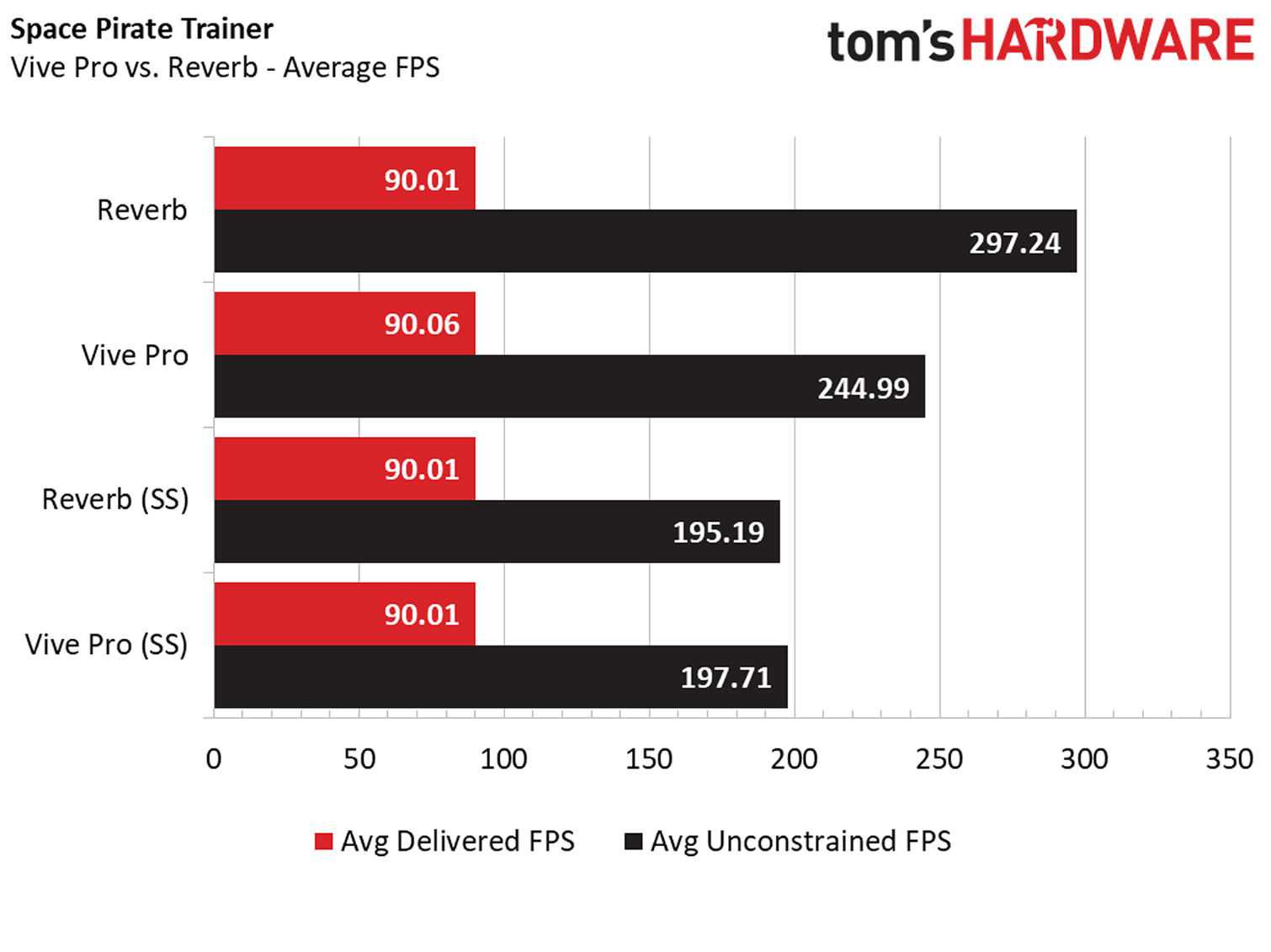
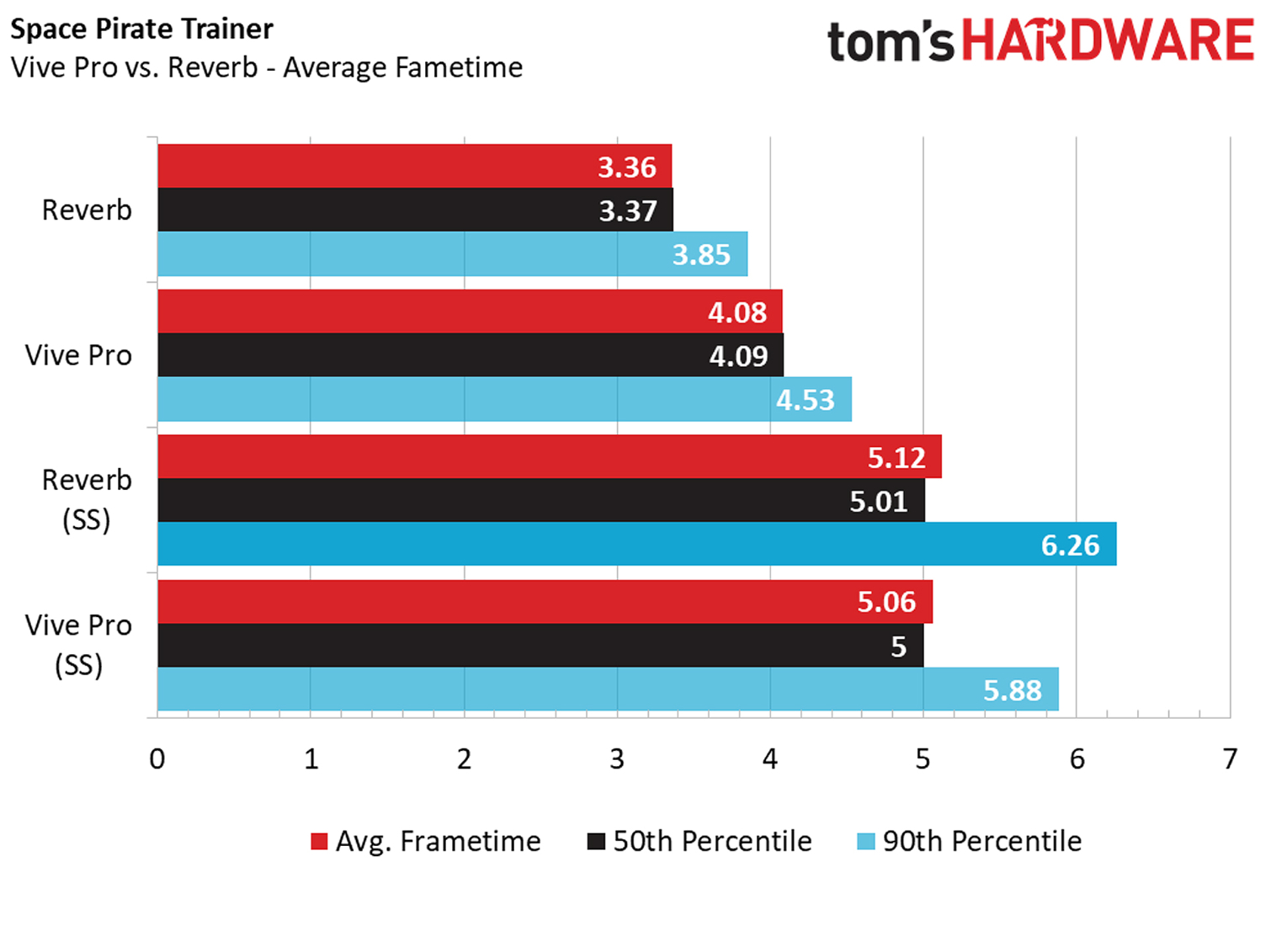
Space Pirate Trainer appears to be optimized better for the Reverb than it is for the Vive Pro. The FCAT VR results show that the unconstrained frame rate on the Vive Pro was around 250 frames per second (fps), whereas our system sent up to 290 fps to the Reverb.
With the resolutions set to their higher values, we observed nearly identical unconstrained frame rates in the range of 195 fps. At no point did our frame rate drop below the required 90 fps threshold.
Beat Saber
Beat Saber isn't a very graphically demanding game, but it requires you to move your hands at a rapid pace. The harder difficulty levels demand swift movement, and poor graphics or display performance could have a meaningful impact on your potential score. The Reverb's ultra-low latency displays did a great job with this kind of usage.
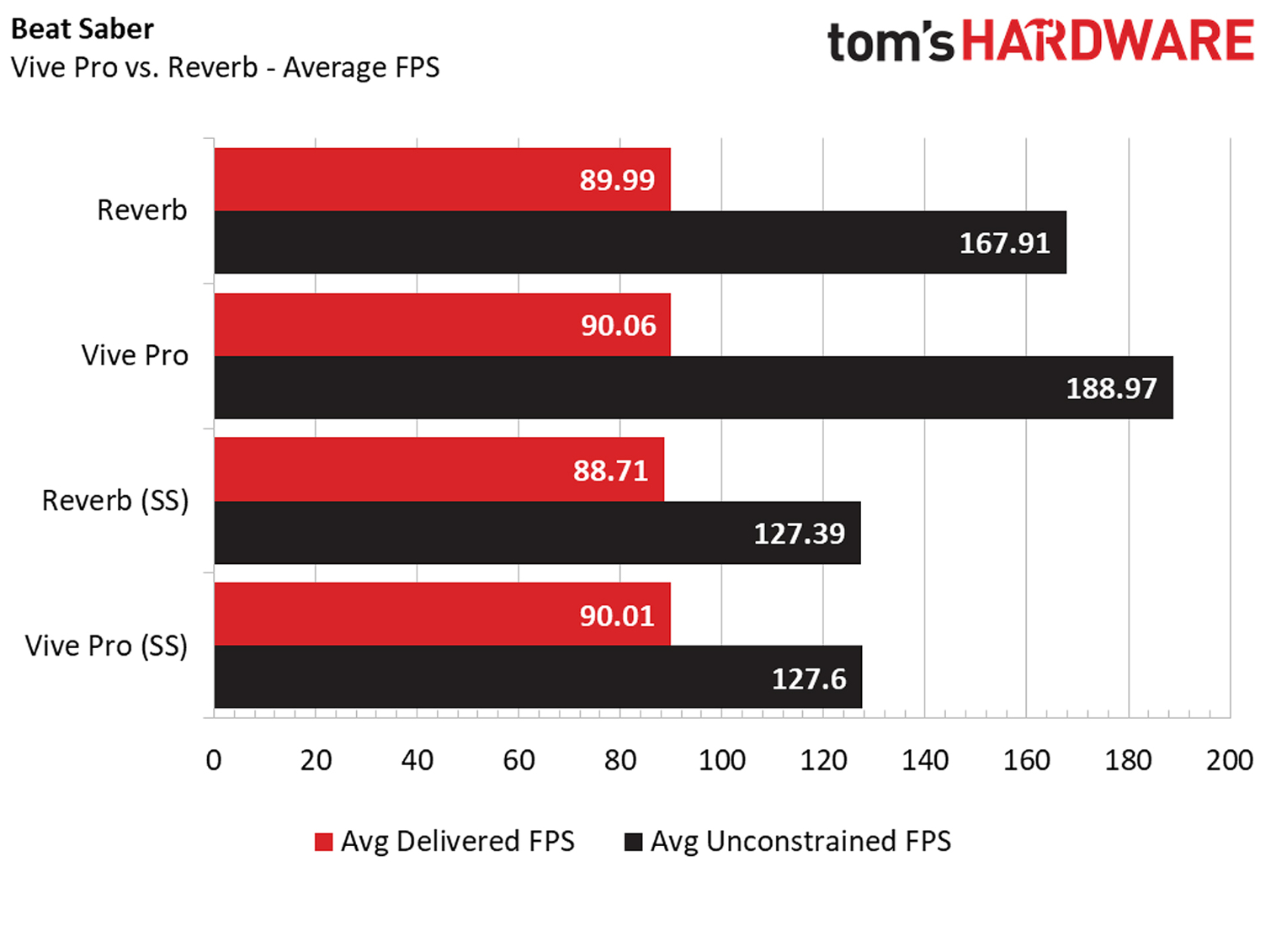
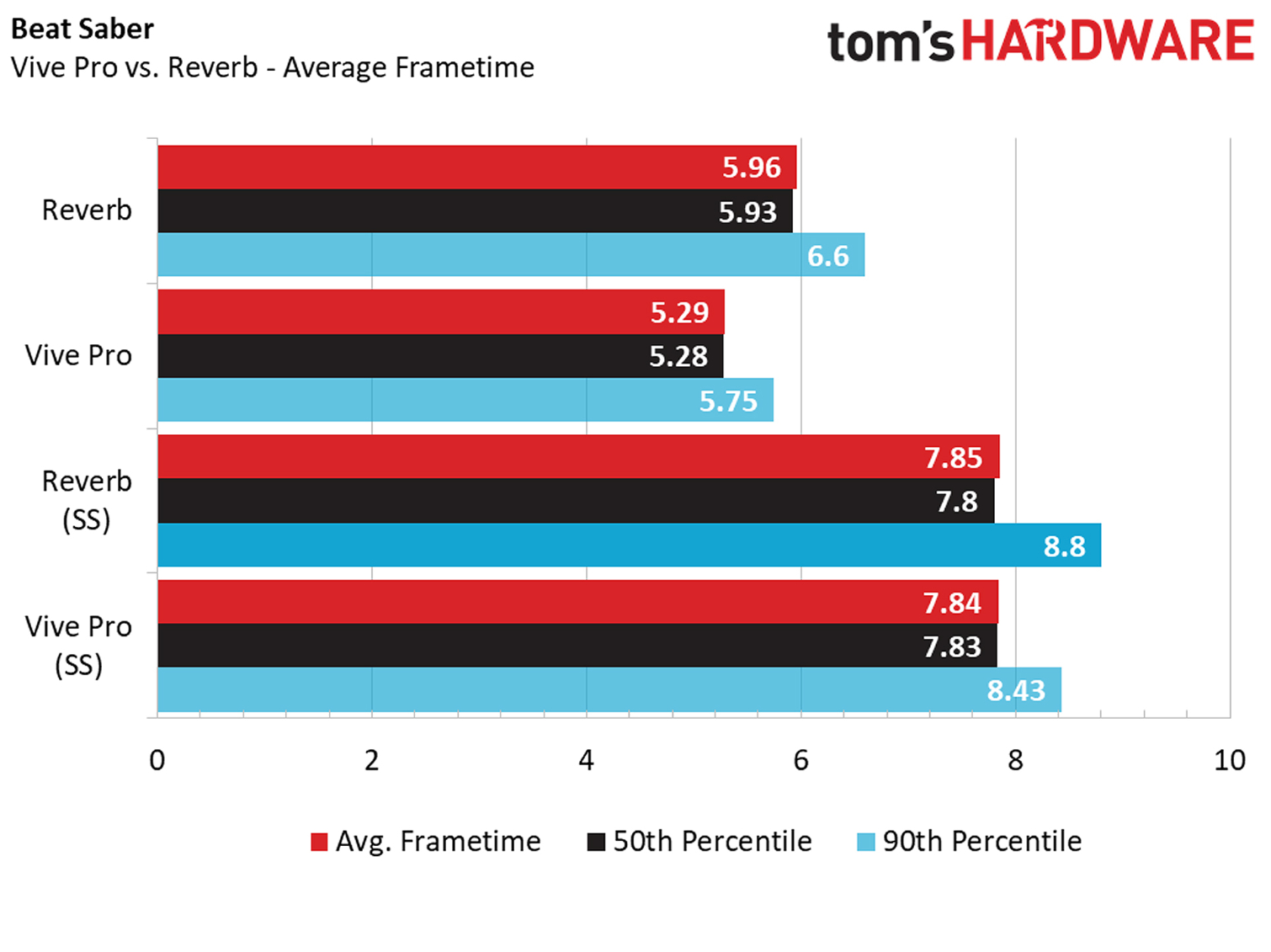
The RTX 2080 in our test system had no trouble delivering enough frames to keep up with the refresh rate of the display. We observed an unconstrained average of over 160 fps, which is nearly double the necessary 90 fps minimum.
With the higher resolution settings, both headsets again saw virtually equal average frame rates. The Reverb enjoyed 127.39 fps, while the Vive Pro saw 127.6 fps on average.
Interestingly, the Reverb’s average delivered fps was a touch below the desired 90 fps with an average of 88.71 fps. This may denote an optimization issue with the Windows MR platform, as the unconstrained performance numbers suggest our system had ample performance to handle to job.
Serious Sam VR: The Last Hope
Serious Sam VR takes place in a bright desert environment with a lot of colorful explosions and firepower, which again lends well to the RGB LCD panels in the Reverb headset. This game highlighted how much better the display in the Reverb compared to the Vive Pro. The higher resolution was extremely evident in the menus of this game.
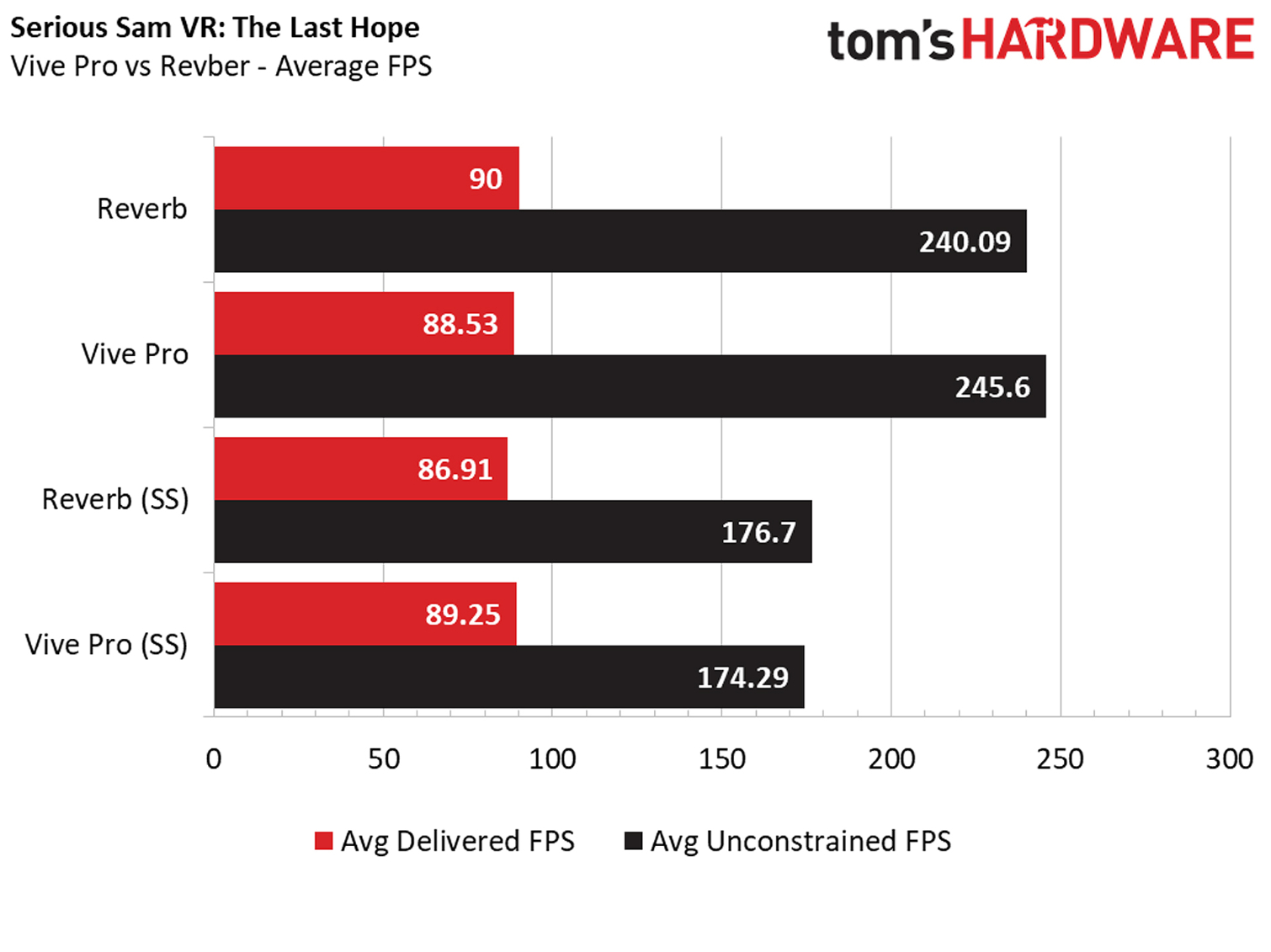
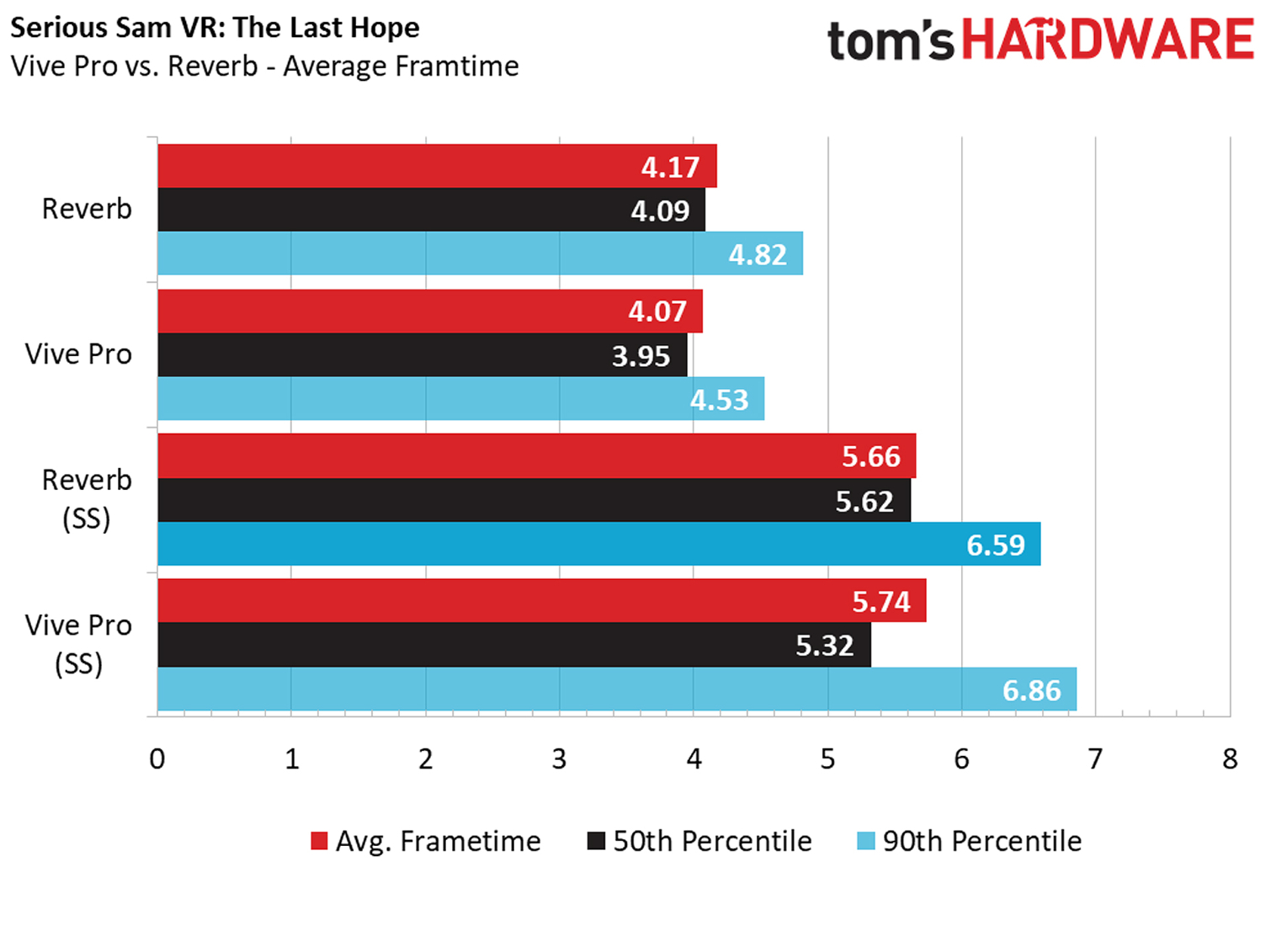
Oddly, Serious Sam VR: The Last Hope is the only game where frame rate fell at the recommended resolution. Our test system didn't have any trouble keeping the frame rate steady on the Reverb at Steam’s recommended resolution, but each time we tested the Vive Pro the results showed that a handful of frames didn't reach their intended destination.
Despite achieving an unconstrained framerate of 245.6 fps, the average frame rate delivered to the Vive Pro was a mere 88.53 fps. The Reverb headset sustained 90 fps at all times, but it had lower unconstrained performance at 240.09 fps.
With the resolution cranked up, our system failed to sustain 90 fps on both headsets. The Vive Pro scored 89.25 fps, which is just shy of the mark. The Reverb suffered with 86.91 fps, which was a noticeable deficit while playing this fast-paced game.
Arizona Sunshine
Arizona Sunshine was the most demanding title in our test suite. I wouldn't say the image quality played a role in the gameplay quality with Arizona Sunshine, but the visuals were noticeably better in the Reverb headset compared to the Vive Pro.
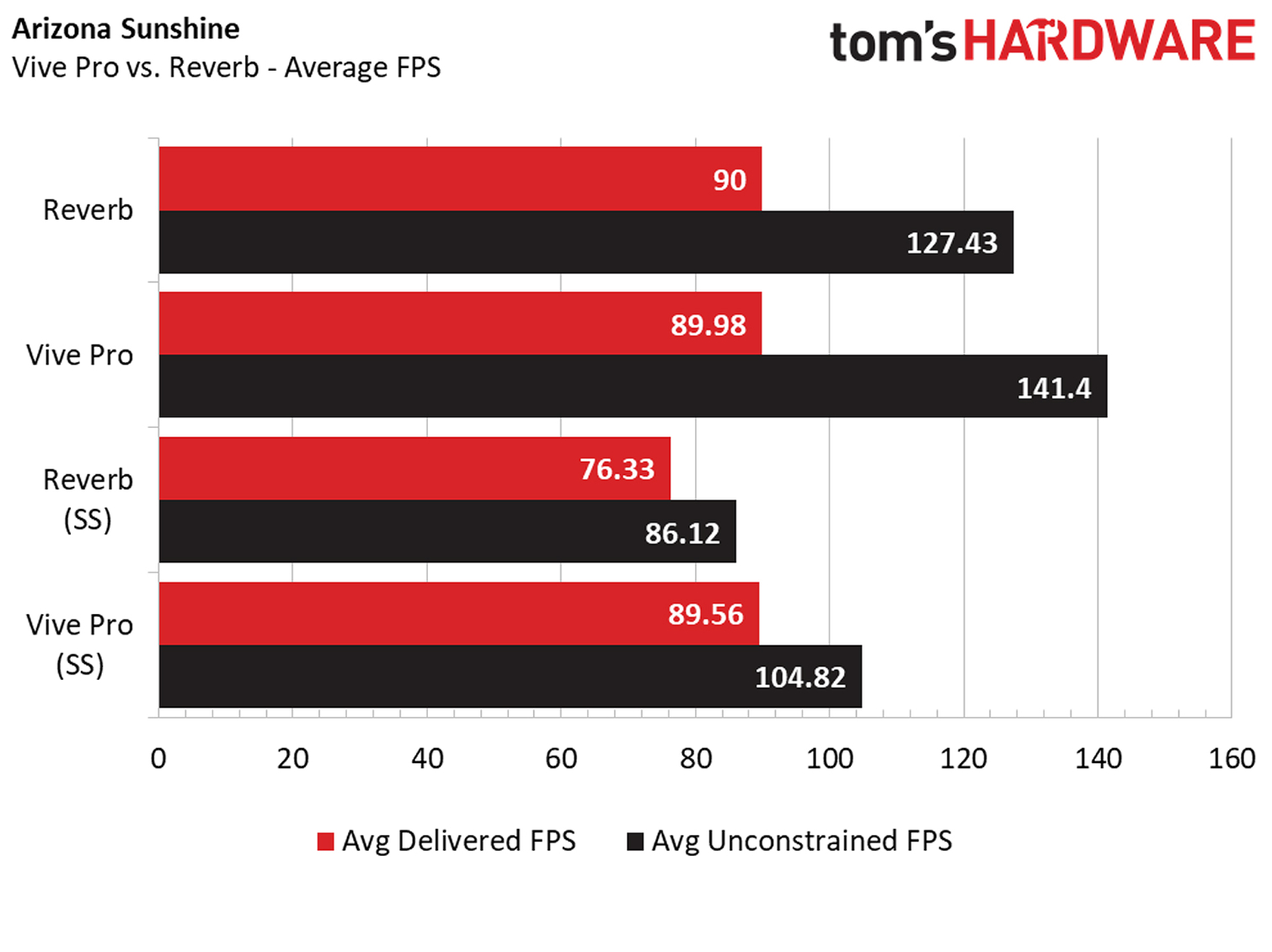
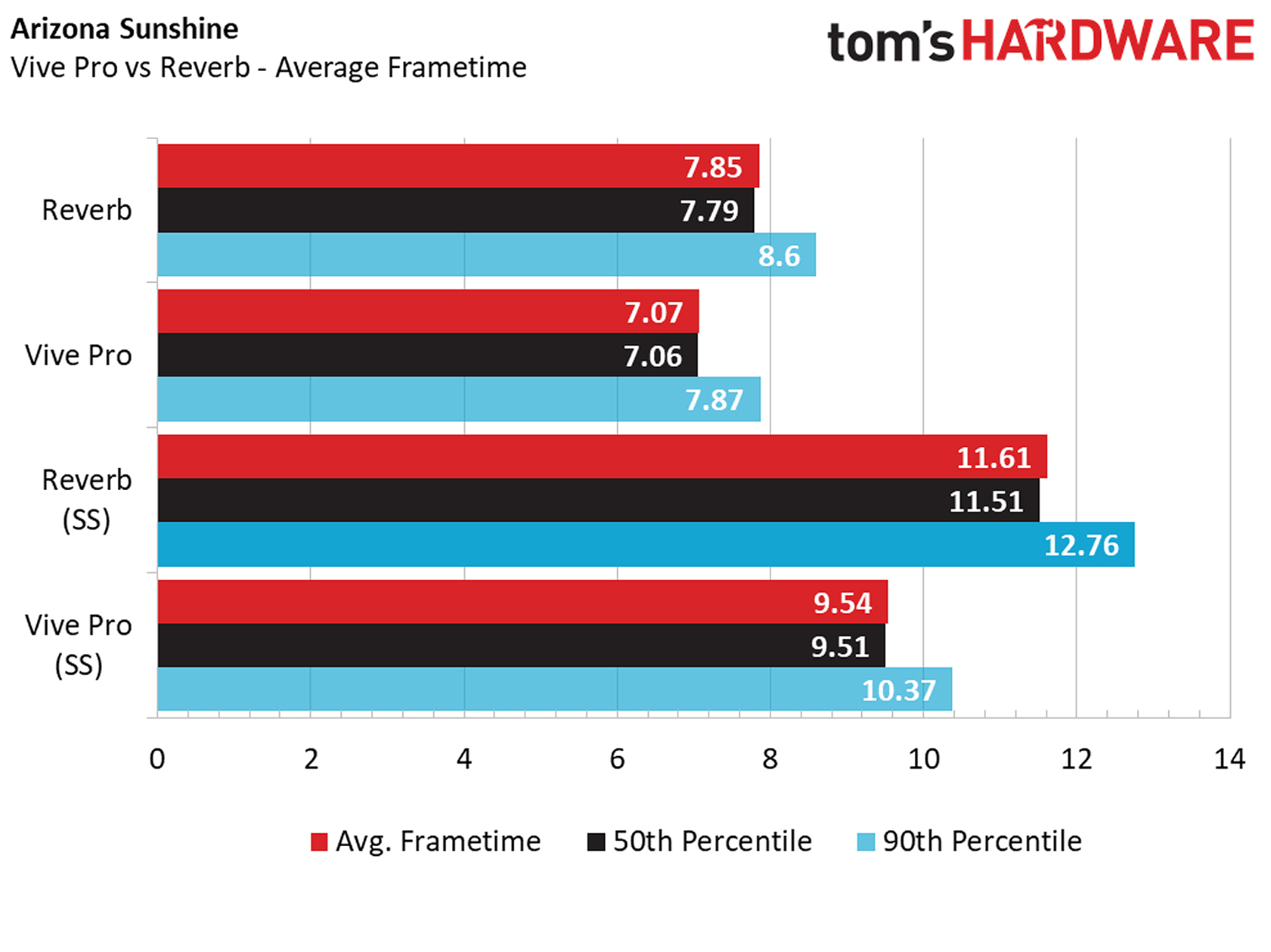
Our test system still managed to deliver more than 90 fps to the headset, but the two headsets’ results were much closer this time. We didn't observe any dropped frames in either headset at their recommended rendering resolutions.
The Reverb averaged a flat 90 fps, with the unconstrained frame rate pegged at 127.43 fps. The Vive Pro averaged 89.98 fps with unconstrained performance good for 141.4 fps.
When we raised the bar with a higher resolution, our test system began to struggle. With the Vive Pro, it did just fine with an average frame rate of 89.56 fps. There wasn’t much headway with the unconstrained performance tagged at 104.82 fps.
The Reverb set to 2749 x 2693 proved to be too much for our RTX 2080-equipped test system. We observed an abysmal 76.33 fps average, and even the unconstrained frame rate couldn’t feed the 90 Hz display.
At this frame rate aiming was difficult, and the game started to make me feel dizzy. It is not worth pushing the resolution to the point where you lose performance.
Conclusion
HP's Reverb is easily the best VR headset in Microsoft's Windows MR lineup. It's a comfortable device, the visuals it produces are crisp and clear and like all Windows MR devices, it's relatively simple to set up.
However, a crucial part of any VR experience is the quality of the hand tracking and input method, and this package falls far short of what I would call the bare minimum for tracking fidelity for 2019. The faulty tracking of the controllers—not to mention the poor ergonomic design—makes it difficult to recommend the Reverb headset over competitors like the HTC Vive Pro.
The price tag doesn't help either. The Reverb starts at $599 for the consumer version, and the Pro edition sells for $649 (it includes a 0.6m headset cable for connecting to the optional HP Z VR backpack). That's a lot of money for a headset with sub-par tracking accuracy and inferior controllers--especially considering the recent competition in the VR headset market.
You would need a good reason to favor the higher resolution over better controllers. Unless the highest resolution image is of critical importance to how you plan on using the headset, you might want to consider other cheaper HMDs over this one, which is a real shame because the image clarity in the Reverb is quite exceptional.
Image Credits: Tom's Hardware
MORE: Best Virtual Reality Headsets
MORE: All Virtual Reality Content
MORE: Virtual Reality Basics
Kevin Carbotte is a contributing writer for Tom's Hardware who primarily covers VR and AR hardware. He has been writing for us for more than four years.
-
1trillion Replykcarbotte said:HP Reverb is the best Windows Mixed Reality headset, but that may be its biggest downfall. It's impressive, but the included controllers ruin the experience.
HP Reverb VR Headset Review: Windows Mixed Reality Never Looked So Good : Read more
kcarbotte said:HP Reverb is the best Windows Mixed Reality headset, but that may be its biggest downfall. It's impressive, but the included controllers ruin the experience.
HP Reverb VR Headset Review: Windows Mixed Reality Never Looked So Good : Read more
I am so frustrated with all the reviews putting down the controllers yet NOT ONE of the Reviews EVER indicates that one could just use the HTC Vive Light house controllers instead of the WMR controllers if the user really wanted better controller accuracy.
It is a super simple fix. Just look on YouTube for simple instructions on how to utilize the Light House controller from the HTC Vive.. (Yes I know it is more expensive to go that route but holy cow people... If the crap controllers from the default WMR equipment bothers you that much then bite the bullet and spend a little more and figure out how to engage the light house controllers from the HTC Vive .... It's super easy to do... and stop your complaining.. )
If you are already into VR that much that you've purchased the high end GPU and CPU combo with a high end VR headset with good resolution then purchasing or 'Using' the light house units from perhaps your previously purchased HTC Vibe should be worth your time and effort (and extra expense if you have to go and purchase them separately )... You've already done 95 percent of the work getting all the other gear setup for a great VR experience why would you stop 'there' and just deal with the crappy WMR controllers.... JUST go the final distance and set up the HTC Vibe light house tracking units with their controllers and have the best of both worlds (great resolution AND great tracking).... ---- Simple enough..... -
cryoburner Reply
You mean "microphones"?kcarbotte said:The Reverb includes two built-in headphones to enable voice recognition for use with Cortana right out of the box.
People shouldn't be expected to use alternate controllers. And of course, adding Vive controllers also means buying and setting up lighthouses, which defeats much of the point of the WMR headsets having self-contained tracking.1trillion said:I am so frustrated with all the reviews putting down the controllers yet NOT ONE of the Reviews EVER indicates that one could just use the HTC Vive Light house controllers instead of the WMR controllers if the user really wanted better controller accuracy.
And in terms of cost, adding a pair of Vive controllers and two lighthouses adds over $500 to the setup, or around $600 if you want the new Index controllers, effectively doubling the cost of the headset. Spending $600 just to get a decent pair of controllers does not seem practical. Likewise it shouldn't be expected that people will already have such equipment on-hand. The majority of existing VR users have headsets that don't use lighthouses, and a lot of the people buying one of these will be first-time VR users, considering how small the existing VR user-base is.
And why shouldn't reviews complain about it? Complaints are likely to lead to the hardware getting improved in future devices, so they should be in your best interest. -
1trillion Replycryoburner said:You mean "microphones"?
People shouldn't be expected to use alternate controllers. And of course, adding Vive controllers also means buying and setting up lighthouses, which defeats much of the point of the WMR headsets having self-contained tracking.
And in terms of cost, adding a pair of Vive controllers and two lighthouses adds over $500 to the setup, or around $600 if you want the new Index controllers, effectively doubling the cost of the headset. Spending $600 just to get a decent pair of controllers does not seem practical. Likewise it shouldn't be expected that people will already have such equipment on-hand. The majority of existing VR users have headsets that don't use lighthouses, and a lot of the people buying one of these will be first-time VR users, considering how small the existing VR user-base is.
And why shouldn't reviews complain about it? Complaints are likely to lead to the hardware getting improved in future devices, so they should be in your best interest.
Complain about it is ok but at least show there is a possible workaround the problem for those who are willing to go the extra step because many people do not know there IS A workaround solution.... -
techguy2 Thank for review and after reading it I am even more looking forward to buying this headset. I do have a few points I disagree with:Reply
"No Flip Visor... HP deleted one of the best features from its first Windows MR headset... You can flip it up slightly, but not enough to clear the proximity sensor that tells the MR Portal to give you mouse and keyboard access on the desktop."
I disagree as this was the first thing that breaks for many people, to they just made more durable headset. In addition it did not work as expected. As a VR apps developer, it should have helped me be able to flip the visor up and see my monitor, but no, I still have to lift my head 45 degrees to see the screen, so even though it is easier than removing the headset completely, unless I have to change just a small thing, it puts too much strain on my neck. With Flashlight features, I can still find my coffee cup without removing the visor.
Proximity sensor capturing cursor was also badly implemented, that at the end I placed piece of masking tape on the sensor so the headset would not constantly turn on, or hijack my mouse/keyboard. This way I can manually switch with win+y to the input mode I need. -
mbaranDET I'm confused, the article states you need an RX VEGA 64 to power the headset? Does this mean for gaming? For non gaming uses, could you use a lower graphics card to power? Would a RX580 power the headset to use in Virtual Desktop/Virtual Cinema? Not to game just to view high 4k movies and large file VR movies? ThanksReply -
cryoburner I suspect they're referring to the hardware that will be needed to run most games well at the headset's native resolution. Some software will undoubtedly be less demanding, and could get away with less powerful graphics hardware.Reply
Once people have the headset, I'm sure we'll hear more about how a wider selection of software performs at its native resolution on various graphics cards. From what I've heard though, the headset missed its planned release date, and still isn't available for sale. -
techguy2 Reply
You need display port 1.3 or 1.4 to be able to push all those pixels at 90Hz refresh rate, but on lower end GPUs that do support that DP1.3 you may not be able to run something like fallout 4 VR but is should be enough for movies and some less intensitive gamesmbaranDET said:I'm confused, the article states you need an RX VEGA 64 to power the headset? Does this mean for gaming? For non gaming uses, could you use a lower graphics card to power? Would a RX580 power the headset to use in Virtual Desktop/Virtual Cinema? Not to game just to view high 4k movies and large file VR movies? Thanks